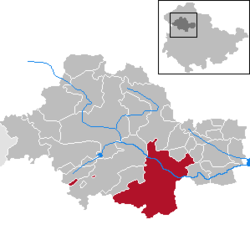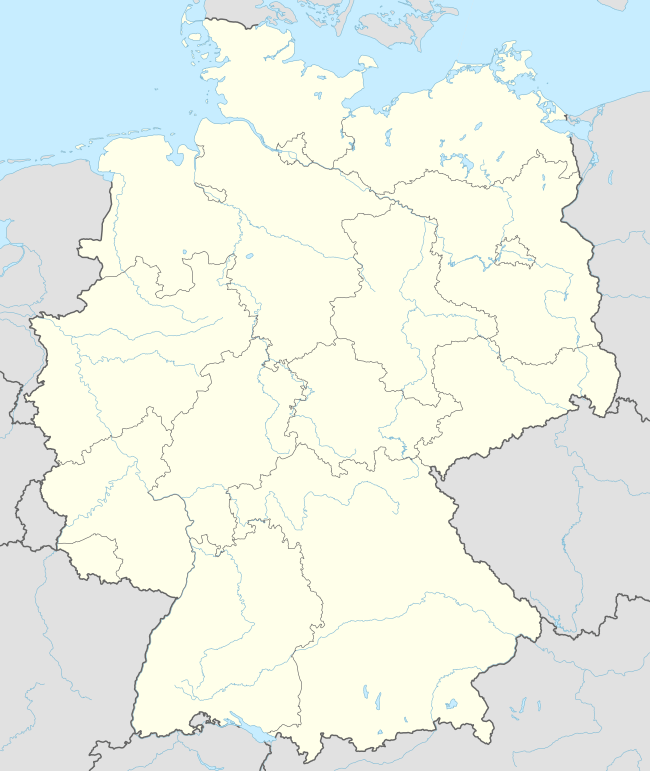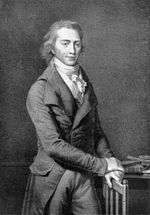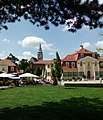Bad Langensalza
Bad Langensalza (pronounced [baːd laŋn̩ˈzaltsaː]; until 1956: Langensalza) is a spa town of 17,500 inhabitants in the Unstrut-Hainich district, Thuringia, central Germany.
Bad Langensalza | |
|---|---|
The historical centre of Bad Langensalza | |
 Coat of arms | |
Location of Bad Langensalza within Unstrut-Hainich-Kreis district  | |
 Bad Langensalza  Bad Langensalza | |
| Coordinates: 51°6′29″N 10°38′48″E | |
| Country | Germany |
| State | Thuringia |
| District | Unstrut-Hainich-Kreis |
| Government | |
| • Mayor | Matthias Reinz (Ind.) |
| Area | |
| • Total | 129.37 km2 (49.95 sq mi) |
| Elevation | 202 m (663 ft) |
| Population (2018-12-31)[1] | |
| • Total | 17,441 |
| • Density | 130/km2 (350/sq mi) |
| Time zone | CET/CEST (UTC+1/+2) |
| Postal codes | 99941–99947 |
| Dialling codes | 03603 |
| Vehicle registration | UH, LSZ, MHL |
| Website | www |
History

The town was first mentioned in historical records ca. 932, as a village named "Salzaha". The town's name was changed to Langensalza ca. 1578, and "Bad" ("Spa") added to the name in 1956.
In 1075, Langensalza was the site of a battle, in which Emperor Henry IV won over the rebelling Saxons and Thuringians.
The town was plundered and damaged by fires during the Thirty Years' War (c. 1632). Fires again destroyed large parts of the town in 1711, including complete destruction of the town hall, which was rebuilt between 1742 and 1752.
War again affected the town between 1756 and 1763, during the Seven Years' War; it was the scene of a battle in February 1761. In 1815 Langensalza became part of the Prussian Province of Saxony. In 1866 it was again the site of a battle between Prussia and Hanover during the Austro-Prussian War.[2]
American troops occupied the town in 1945.
Main sights
Langensalza is something of a tourist spot, with a well-preserved medieval old town, a number of themed public gardens and a thermal spa bath.[3]
Sulphur springs were discovered in 1811 and opened to the public as a curative bath in 1812. A new version of the public sulphur bath was opened in 1928. Salt and mineral water springs were discovered in 1996, which prompted the opening of many new curative facilities. Today a modern thermal bath attracts many visitors.
Bad Langensalza contains a Botanical Garden, along with a Rose Garden, a Magnolia Garden and an Arboretum. It is one of the few European towns with an authentic Japanese Garden. Bad Langensalza is also close to the Hainich National Park, Germany's oldest deciduous forest.
The town is on the German Timber-Frame Road (Fachwerkstraße) and is notable for the number of well-preserved medieval half-timbered (Fachwerk) houses.
Travertine stone has been mined in the town since medieval times, and is still carved there today. It forms the distinctive white stonework of the old town. Travertine from Bad Langensalza was used in one of the most famous works of modern architecture, the Barcelona Pavilion by Ludwig Mies van der Rohe.
Cultural
The then Augustinian monk Martin Luther visited Langensalza's Augustinian Cloister in 1516 in his role as District Vicar. As a result the town is now on the Luther Trail (Lutherweg). The poet Klopstock lived in Langensalza between 1748 and 1750, where he composed some of his most famous odes. His sumptuous house is still standing in the Salzstraße. The poet Novalis lived for a time in Langensalza in 1796 whilst studying chemistry under Johann Christian Wiegleb at his house in the Markstraße. Christoph Wilhelm Hufeland, the most eminent German physician of the 19th Century, was born in Langensalza. He is buried in the famous Dorotheenstadt Cemetery in Berlin.
Notable people

- Hermann von Salza (around 1170-1239), 4th Master of the Teutonic Order
- Georg Neumark (1621-1681), composer and poet
- Johann Christian Wiegleb (1732-1800), naturalist and pharmacist
- Christoph Wilhelm Hufeland (1762-1836), physician, founder of macrobiotics
- Hermann Bonitz (1814-1888), scholar and educator
- Ulrich Kleemann (1892-1963), general of tank troops in Second World War
- Rudolf Batz (1903-1961), Sturmbannführer, leader of Einsatzkommando 2, responsible for the mass murder of Jews in the Baltics
- Dieter Fromm (born 1948), middle-distance runner
- Uwe Barth (born 1964), politician (FDP)
- Radost Bokel (born 1975), actress
- Claudia Schramm (born 1975), bobsledder
- Enrico Kühn (born 1977), bobsledder
- Marco Engelhardt (born 1980), football player
- Silvio Heinevetter (born 1984), handball goalkeeper
- Matthias Rahn (born 1990), footballer
References
- "Bevölkerung der Gemeinden, erfüllenden Gemeinden und Verwaltungsgemeinschaften nach Geschlecht in Thüringen Gebietsstand: 31.12.2018". Thüringer Landesamt für Statistik (in German). September 2019.
- Chisholm, Hugh, ed. (1911). . Encyclopædia Britannica. 16 (11th ed.). Cambridge University Press. p. 174.
- https://www.badlangensalza.de/en/
External links

- Official website
Gallery
- Market Church
- Town Hall
- Friederikenschlösschen
- Klagentor (one of the medieval town gates)
 One of the 30 medieval town wall towers
One of the 30 medieval town wall towers Frederikenschlösschen with Market Church in background
Frederikenschlösschen with Market Church in background Langensalza from nearby Merxleben
Langensalza from nearby Merxleben